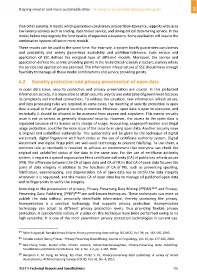Page 711 - Shaping smarter and more sustainable cities - Striving for sustainable development goals
P. 711
than other systems. A model, which guarantees consistency and partition‐tolerance, supports wide‐area
low‐latency services such as trading, data broker service, and timing‐critical data mining service. In this
model, failure may degrade the functionality of separated subsystems. Some application will require the
combination systems of two or more models.
These modes can be used at the same time. For example, a system locally guarantees consistency
and availability and widely guarantees availability and partition‐tolerance. Each service and
application of SSC defines the marginal type of different models. Moreover, the service and
application defines the service providing points in the hierarchical network structure, namely where
the service and application are provided. The information infrastructure of SSC should have enough
flexibility to manage all these model combinations and service providing points.
4.2 Security protection and privacy preservation of open data
In open data issue, security protection and privacy preservation are crucial. In this globalized
information society, it is impossible to attain security only by one enterprise of government because
its complexity and meshed connections. To address this situation, new information infrastructure,
and data processing rules are required. In some cases, the meaning of security protection in open
data is equal to that of general security protection. However, open data is open to everyone, and
technically it should be allowed to be accessed from anyone and anywhere. This means security
issue is not as serious as generally discussed security. However, the access to the open data is
regulated because of its license or its charge of usage. Accounting, usageconfirmation and illegal
usage protection, could be the main issue of the security in using open data. Another security issue
is original and unfalsified authenticity. This authenticity will be given by the technique of digital
watermark, digital fingerprint with hash codes or the use of certificate authority system. Digital
watermark and digital fingerprint are well‐used technology to prevent falsifying. To use them, a
common rule as standards is required to achieve an environment that everyone can check the
original and unfalsified status of the data in the same way. For the use of certificate authority
system, it requires a special organization like a certificate authority (CA) of public key infrastructure
(PKI). The difference between the CA of open data and CA of PKI is that CA of open data focuses the
point of data integrity in addition to the functions of CA of PKI, such as preventing spoofing,
falsification, eavesdropping, and degeneration. CA of open data has to certify the data integrity
whenever it is requested, and this means CA of open data has to manage all published open data
and its fingerprints to verify the integrity.
According to the preservation of privacy, Privacy‐Preserving Data Mining (PPDM) 2324 and Privacy‐
Preserving Data Publishing (PPDP) 2526 are well‐known techniques. These techniques can mine or
publish the data without personally identifiable information, thereby protecting the privacy.
Anonymization is a practical technology that supports privacy protection. Anonymization
technology can adjust to different privacy protection levels, thus providing flexible privacy
protection. A considerable variety of studies on this technique have been performed owing to its
high versatility. It is one of the most preeminent privacy protection technologies in current use.
____________________
23 Rakesh Agrawal; Ramakrishnan Srikant; Privacy‐preserving data mining; SIG‐MOD, Vol. 29, pp. 439‐450, 2000.
24 Yehuda Lindell; Benny Pinkas; “Privacy Preserving Data Mining; Journal of Cryptology, Vol. 15, pp. 177‐206, 2002.
25 Bee‐Chung Chen; Daniel Kifer; Kristen LeFevre; AshwinMachanavajjhala; Privacy‐Preserving Data Publishing;
Foundations and Trends in Databases, Vol. 2, No. 1‐2, pp. 1‐167, 2009.
26 Benjamin C. M. Fung; Ke Wang; Rui Chen; Philip S. Yu; Privacy‐preserving data publishing: A survey of recent
developments; ACM Computing Surveys (CSUR), Vol. 42, No. 4, 2010.
ITU‐T's Technical Reports and Specifications 701

